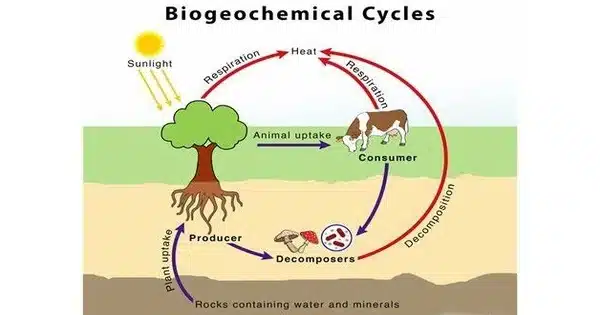A biogeochemical cycle is the movement of a chemical element or molecule through both living organisms and non-living components of the Earth’s environment. It is the exchange of chemical elements and compounds between living creatures, the atmosphere, and the Earth’s crust. These cycles are critical for sustaining the necessary balance of elements for life on Earth.
The carbon cycle, nitrogen cycle, and water cycle are all important biogeochemical cycles. The chemical element or molecule is altered and cycled by living creatures and through numerous geological forms and reservoirs, such as the atmosphere, soil, and oceans, in each cycle. The carbon cycle, nitrogen cycle, phosphorus cycle, sulfur cycle, and water cycle are the major biogeochemical cycles.
- Carbon Cycle: Carbon is an essential element for life, and its cycle includes photosynthesis, respiration, breakdown, and combustion. It comprises carbon exchange between the atmosphere, oceans, soil, and biological creatures.
- Nitrogen Cycle: Nitrogen is required by living organisms for the creation of proteins and nucleic acids. Nitrogen fixation, nitrification, denitrification, and ammonification are all part of the nitrogen cycle. Bacteria are critical in turning nitrogen into various forms that plants can use.
- Phosphorus Cycle: Phosphorus is a key component of DNA, RNA, and ATP. The phosphorus cycle involves the movement of phosphorus through the lithosphere, hydrosphere, and biosphere. Weathering of rocks releases phosphorus into the soil, where it is absorbed by plants and then transferred to animals through the food chain.
- Sulfur Cycle: Sulfur is an essential element for the synthesis of amino acids and vitamins. The sulfur cycle includes processes such as weathering of rocks, volcanic activity, and microbial transformations. Sulfur compounds are cycled through the atmosphere, hydrosphere, and lithosphere.
- Water Cycle: The hydrological cycle, sometimes known as the water cycle, is the continual movement of water through the atmosphere, land, and oceans. Evaporation, condensation, precipitation, runoff, and transpiration are examples of processes. Water is required for a variety of biological and physical activities on Earth.
These cycles interact with one another, and their balance is critical for the sustainability of life on our planet. Human activities such as the use of fossil fuels, deforestation, and industrial operations can have a large impact on these cycles, resulting in environmental issues such as climate change, nutrient imbalances, and water pollution. Understanding and controlling biogeochemical cycles is so critical for ensuring a healthy and sustainable ecosystem.
















